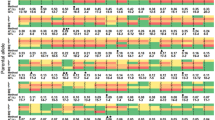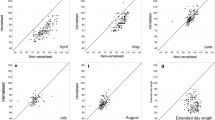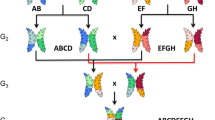Abstract
Association mapping and linkage mapping were used to identify quantitative trait loci (QTL) and/or causative mutations involved in the control of flowering time in cultivated sunflower Helianthus annuus. A panel of 384 inbred lines was phenotyped through testcrosses with two tester inbred lines across 15 location × year combinations. A recombinant inbred line (RIL) population comprising 273 lines was phenotyped both per se and through testcrosses with one or two testers in 16 location × year combinations. In the association mapping approach, kinship estimation using 5,923 single nucleotide polymorphisms was found to be the best covariate to correct for effects of panel structure. Linkage disequilibrium decay ranged from 0.08 to 0.26 cM for a threshold of 0.20, after correcting for structure effects, depending on the linkage group (LG) and the ancestry of inbred lines. A possible hitchhiking effect is hypothesized for LG10 and LG08. A total of 11 regions across 10 LGs were found to be associated with flowering time, and QTLs were mapped on 11 LGs in the RIL population. Whereas eight regions were demonstrated to be common between the two approaches, the linkage disequilibrium approach did not detect a documented QTL that was confirmed using the linkage mapping approach.









Similar content being viewed by others
References
Achard P, Renou JP, Berthomé R, Harberd NP, Genschik P (2008) Plant DELLAs restrain growth and promote survival of adversity by reducing the levels of reactive oxygen species. Curr Biol 18:656–660
Allard RW, Bradshaw AD (1964) Implications of genotype-environmental interactions in applied plant breeding. Crop Sci.4:503–508
Andersen JR, Schrag T, Melchinger AE, Zein I, Lübberstedt T (2005) Validation of Dwarf8 polymorphisms associated with flowering time in elite European inbred lines of maize (Zea mays L.). Theor Appl Genet 111:206–217
Aranzana MJ, Kim S, Zhao K, Bakker E, Horton M et al (2005) Genome-wide association mapping in Arabidopsis identifies previously known flowering time and pathogen resistance genes. PLoS Genet 1:e60
Arcade A, Labourdette A, Falque M, Mangin B, Chardon F, Charcosset A, Joets J (2004) BioMercator: integrating genetic maps and QTL towards discovery of candidate genes. Bioinformatics 20:2324–2326
Atwell S, Huang YS, Vilhjalmsson BJ, Willems G, Horton M, Li Y et al (2010) Genome-wide association study of 107 traits in Arabidopsis thaliana inbred lines. Nature 465:627–631
Austin DF, Lee M, Veldboom LR, Hallauer AR (2000) Genetic mapping in maize hybrid progeny across testers and generations: grain yield and grain moisture. Crop Sci 40:30–39
Baack EJ, Sapir Y, Chapman MA, Burke JM, Rieseberg LH (2008) Selection on domestication traits and QTLs in crop-wild sunflower hybrids. Mol Ecol 17:666–677
Benjamini Y, Hochberg Y (1995) Controlling the false discovery rate: a practical and powerful approach to multiple testing. J Roy Stat Soc B Met 57:289–300
Bert PF, Jouan I, Tourvielle de Labrouhe D, Serre F, Philippon J, Nicolas P, Vear F (2003) Comparative genetic analysis of quantitative traits in sunflower (Helianthus annuus L.). 3. Characterisation of QTL involved in developmental and agronomic traits. Theor Appl Genet 107:181–189
Blackman BK, Rasmussen DA, Strasburg JL, Raduski AR, Burke JM, Knapp SJ, Michaels SD, Rieseberg LH (2011) Contributions of flowering time genes to sunflower domestication and improvement. Genetics 187:271–287
Bouzidi MF, Badaoui S, Cambon F, Vear F, De Labrouche DT, Nicolas P, Mouzeyar S (2002) Molecular analysis of a major locus for resistance to downy mildew in sunflower with specific PCR-based markers. Theor Appl Genet 104:600–952
Bowers JE, Bachlava E, Brunick RL, Rieseberg LH, Knapp SJ, Burke JM (2012) Development of a 10,000 locus genetic map of the sunflower genome based on multiple crosses. Genes Genomes Genetics 2:721–729
Brachi B, Faure N, Horton M, Flahauw E, Vazquez A et al (2010) Linkage and association mapping of Arabidopsis thaliana flowering time in nature. PLoS Genet 6:e1000940
Breseghello F, Sorrells ME (2006) Association analysis as a strategy for improvement of quantitative traits in plants. Crop Sci 46:1323–1330
Buckler ES, Holland JB, Bradbury PJ, Acharya CB, Brown PJ et al (2009) The genetic architecture of maize flowering time. Science 325:714–718
Burke JM, Tang S, Knapp SJ, Rieseberg LH (2002) Genetic analysis of sunflower domestication. Genetics 161:1257–1267
Butler DG, Cullis BR, Gilmour AR, Gogel BJ (2007) ASReml-R reference manual. The State of Queensland, Department of Primary Industries and Fisheries, Brisbane
Charcosset A, Mangin B, Moreau L, Combes L, Jourjon MF (2000) Heterosis in maize investigated using connected RIL populations. In: Quantitative genetics and breeding methods: the way ahead. INRA, Paris, pp 89–98
Coque M, Mesnildrey S, Romestant M, et al (2008) Sunflower lines core collections for association studies and phenomics. In: Proceedings ASTA Conference, Cordoba
Crouzillat D, De la Canal L, Perrault A, Ledoigt G, Vear F, Serieys H (1991) Cytoplasmic male sterility in sunflower: comparison of molecular biology and genetic studies. Plant Mol Biol 16:415–426
Evanno G, Regnaut S, Goudet J (2005) Detecting the number of clusters of individuals using the software STRUCTURE: a simulation study. Mol Ecol 14:2611–2620
Famoso AN, Zhao K, Clark RT, Tung C, Wright MH, Kochian LV, McCouch SR (2011) Genetic architecture of aluminum tolerance in rice (Oryza sativa) determined through genome-wide association analysis and QTL mapping. PLoS Genet 7:e1002221
Flint-Garcia SA, Thornsberry JM, Buckler ES (2003) Structure of linkage disequilibrium in plants. Annu Rev Plant Biol 54:357–374
Flint-Garcia SA, Thuillet A-C, Yu J, Pressoir G, Romero SM, Mitchell SE, Doebley J, Kresovich S, Goodman MM, Buckler ES (2005) Maize association population: a high-resolution platform for quantitative trait locus dissection. Plant J 44:1054–1064
Fusari CM, Lia VV, Hopp HE, Heinz RA, Paniego NB (2008) Identification of single nucleotide polymorphisms and analysis of linkage disequilibrium in sunflower elite inbred lines using the candidate gene approach. BMC Plant Biol 8:7
Fusari CM, Rienzo JA, Troglia C (2012) Association mapping in sunflower for Sclerotinia head rot resistance. BMC Plant Biol 12:93
Gallais A (1984) An analysis of heterosis vs. inbreeding effects with an autotetraploid cross-fertilized plant Medicago sativa L. Genetics 106:123–137
Gaut BS, Long AD (2003) The lowdown on linkage disequilibrium. Plant Cell 15:1502–1506
Gentzbittel L, Zhang YX, Vear F, Griveau B, Nicolas P (1994) RFLP studies of genetic relationships among inbred lines of the cultivated sunflower, Helianthus annuus L.: evidence for distinct restorer and maintainer germplasm pools. Theor Appl Genet 89:419–425
Hallauer AR, Miranda JB (1988) Quantitative genetics in maize breeding. Iowa State Univ Press, Ames
Hill WG, Weir BS (1988) Variances and covariances of squared linkage disequilibria in finite populations. Theor Popul Biol 33:54–78
Holland JB (2004) Implementation of molecular markers for quantitative traits in breeding programs—challenges and opportunities. In: Fischer T, Turner N, Angus J, McIntyre L, Robertson M, Borrell A, Lloyd D (eds) New directions for a diverse planet: proceedings for the 4th international crop science congress. Brisbane, Australia
Horne EC, Kumpatla SP, Patterson KA, Gupta M, Thompson SA (2004) Improved high-throughput sunflower and cotton genomic DNA extraction and PCR fidelity. Plant Mol Biol Rep 22:83a–83i
Ingvarsson PK (2005) Nucleotide polymorphism and linkage disequilibrium within and among natural populations of European aspen (Populus tremula L., Salicaceae). Genetics 169:945–953
Jourjon MF, Jasson S, Marcel J, Ngom B, Mangin B (2005) MCQTL: multi-allelic QTL mapping in multi-cross design. Bioinformatics 21:128–130
Jung M, Ching A, Bhattramakki D, Dolan M, Tingey S et al (2004) Linkage disequilibrium and sequence diversity in a 500-kbp region around the adh1 locus in elite maize germplasm. Theor Appl Genet 109:681–689
Kane NC, Gill N, King MG, Bowers JE, Berges H et al (2011) Progress towards a reference genome for sunflower. Botany 89:429–437
Kang HM, Zaitlen NA, Wade CM, Kirby A, Heckerman D, Daly MJ, Eskin E (2008) Efficient control of population structure in model organism association mapping. Genetics 178:1709–1723
Kolkman JM, Berry ST, Leon AJ, Slabaugh MB, Tang S, Gao W et al (2007) Single nucleotide polymorphisms and linkage disequilibrium in sunflower. Genetics 177:457–468
Lander ES, Botstein DB (1989) Mapping Mendelian factors underlying quantitative traits using RFLP linkage maps. Genetics 121:185–199
Leon AJ, Andrade FH, Lee M (2000) Genetic mapping of factors affecting quantitative variation for flowering in sunflower. Crop Sci 40:404–407
Leon AJ, Lee M, Andrade FH (2001) Quantitative trait loci for growing degree days to flowering and photoperiod response in Sunflower (Helianthus annuus L.). Theor Appl Genet 102:497–503
Luna A, Nicodemus KK (2007) snp.plotter: an R-based SNP/haplotype association and linkage disequilibrium plotting package. Bioinformatics 23:774–776
Mackay TFC (2001) The genetic architecture of quantitative traits. Annu Rev Genet 35:303–339
Mackay I, Powell W (2007) Methods for linkage disequilibrium mapping in crops. Trends Plant Sci 12:57–63
Maenhout S, De Baets B, Haesaert G (2009) Marker-based estimation of the coefficient of coancestry in hybrid breeding programmes. Theor Appl Genet 118:1181–1192
Mandel JR, Dechaine JM, Marek LF, Burke JM (2011) Genetic diversity and population structure in cultivated sunflower and a comparison to its wild progenitor, Helianthus annuus L. Theor Appl Genet 123:693–704
Mangin B, Siberchicot A, Nicolas S, Doligez A, This P et al (2011) Novel measures of linkage disequilibrium that correct the bias due to population structure and relatedness. Heredity 108:285–291
Maynard Smith J, Haigh J (1974) The hitch-hiking effect of a favorable gene. Genet Res 23:23–35
Melchinger AE, Utz HF, Schon CC (1998) Quantitative trait locus (QTL) mapping using different testers and independent population samples in maize reveals low power of QTL detection and large bias in estimates of QTL effects. Genetics 149:383–403
Mestries E, Gentzbittel L, Labrouhe DT, Nicolas P, Vear F, Am S (1998) Analyses of quantitative trait loci associated with resistance to Sclerotinia sclerotiorum in sunflowers (Helianthus annuus L.) using molecular markers. Mol Breed 4:215–226
Mir RR, Kumar N, Jaiswal V, Girdharwal N, Prasad M, Balyan HS, Gupta PK (2012) Genetic dissection of grain weight in bread wheat through quantitative trait locus interval and association mapping. Mol Breed 29:963–972
Mokrani L, Gentzbittel L, Azanza F, Fitamant L, Al-Chaarani G, Sarrafi A (2002) Mapping and analysis of quantitative trait loci for grain oil and agronomic traits using AFLP and SSR in sunflower (Helianthus annuus L.). Theor Appl Genet 106:149–156
Myles S, Peiffer J, Brown PJ, Ersoz ES, Zhang Z, Costich DE, Buckler ES (2009) Association mapping: critical considerations shift from genotyping to experimental design. Plant Cell 21:2194–2220
Nordborg M, Weigel D (2008) Next-generation genetics in plants. Nature 456:720–723
Nordborg M, Hu TT, Ishino Y, Jhaveri J, Toomajian C, Zheng H, Bakker E, Calabrese P, Gladstone J, Goyal R, Jakobsson M, Kim S, Morozov Y, Padhukasahasram B, Plagnol V, Rosenberg NA, Shah C, Wall J, Wang J, Zhao K, Kalbfleisch T, Schultz V, Kreitman M, Bergelson J (2005) The pattern of polymorphism in Arabidopsis thaliana. PLoS Biol 3:e196
Patterson N, Price AL, Reich D (2006) Population structure and Eigen analysis. PLoS Genet 2:e190
Poormohammad Kiani S, Maury P, Nouri L, Ykhlef N, Grieu P, Sarrafi A (2009) QTL analysis of yield-related traits in sunflower under different water treatments. Plant Breeding 128:363–373
Pritchard JK, Stephens M, Donnelly P (2000) Inference of population structure using multilocus genotype data. Genetics 155:945–959
R Development Core Team (2012) R: A language and environment for statistical computing. R Foundation for Statistical Computing, Vienna. ISBN 3-900051-07-0
Rafalski JA (2002) Novel genetic mapping tools in plants: SNPs and LD-based approaches. Plant Sci 162:329–333
Raman H, Raman R, Eckermann P et al (2012) Genetic and physical mapping of flowering time loci in canola (Brassica napus L.). Theor Appl Genet 126:119–132
Rieseberg LH, Willis JH (2007) Plant speciation. Science 317:910–914
Sarnowski TJ, Świez S, Pawlikowska K, Kaczanowski S, Jerzmanowski A (2002) AtSWI3B, an Arabidopsis homolog of SWI3, a core subunit of yeast Swi/Snf chromatin remodeling complex, interacts with FCA, a regulator of flowering time. Nucl Acids Res 30:3412–3421
Shen CH, Krishnamurthy R, Yeh KW (2009) Decreased l-ascorbate content mediating bolting is mainly regulated by the galacturonate pathway in Oncidium. Plant Cell Physiol 50:935–946
Sun TP (2010) Gibberellin-GID1-DELLA: a pivotal regulatory module for plant growth and development. Plant Physiol 154:567–570
Sun G, Zhu C, Kramer MH, Yang SS, Song W, Piepho HP, Yu J (2010) Variation explained in mixed-model association mapping. Heredity 105:333–340
Tenaillon MI, Sawkins MC, Long AD, Gaut RL, Doebley JF et al (2001) Patterns of DNA sequence polymorphism along chromosome 1 of maize (Zea mays ssp. mays L.). Proc Natl Acad Sci USA 98:9161–9166
Thornsberry JM, Goodman MM, Doebley J et al (2001) Dwarf8 polymorphisms associate with variation in flowering time. Nature genet 28:286–289
Tian F et al (2011) Genome-wide association study of leaf architecture in the maize nested association mapping population. Nat Genet 43:159–162
Vear F, Serre F, Jouan-Dufournel, Bert I, Roche PF, Walser SP, de Labrouhe DT, Vincourt P (2008) Inheritance of quantitative resistance to downy mildew (Plasmopara halstedii) in sunflower (Helianthus annuus L.). Euphytica 164:561–570
Vincourt P, As Sadi F, Bordat A, Langlade N, Gouzy J, Pouilly N, Lippi Y, Serre F, Godiard L, Tourvieille de Labrouhe D, Vear F (2012) Consensus mapping of major resistance genes and independent QTL for quantitative resistance to sunflower downy mildew. Theor Appl Genet 5:909–920
Wills DM, Burke JM (2007) Quantitative trait locus analysis of the early domestication of sunflower. Genetics 176:2589–2599
Wright S (1951) The genetic structure of populations. Ann Eugen 15:323–354
Xu L, Zhao Z, Dong A et al (2008) Di-and tri-but not monomethylation on histone H3 lysine 36 marks active transcription of genes involved in flowering time regulation and other processes in Arabidopsis thaliana. Mol Cell Biol 28:1348–1360
Yan J, Warburton ML, Crouch J (2011) Association mapping for enhancing maize (Zea mays L.) genetic improvement. Crop Sci 51:433–449
Yu JM, Pressoir G, Briggs WH, Bi IV, Yamasaki M, Doebley JF, McMullen MD, Gaut BS, Nielsen DM, Holland JB, Kresovich S, Buckler ES (2006) A unified mixed-model method for association mapping that accounts for multiple levels of relatedness. Nat Genet 38:203–208
Zhao K, Aranzana MJ, Kim S, Lister C, Shindo C, Tang C, Toomajian C, Zheng H, Dean C, Marjoram P, Nordborg M (2007) An Arabidopsis example of association mapping in structured samples. PLoS Genet 3:e4
Acknowledgments
We would like to thank M.C. Boniface and D. Varès (INRA Toulouse), H. Bony, G. Joubert, F. Serre, S. Roche and J. Philippon (INRA Clermont-Ferrand), Th. André (SOLTIS), S. Châtre (RAGT), P. George and M. Barthes (BIOGEMMA) and colleagues from SYNGENTA Seeds for their involvement in sunflower trial management. This work benefited from the GENOPLANTE program “HP1” (2001–2004), the “SUNYFUEL” project, financially supported by the French National Research Agency (2008–2011), and the “OLEOSOL” project (2009–2012) with the financial support from the Midi Pyrénées Region, the European Fund for Regional Development (EFRD), and the French Fund for Competitiveness Clusters (FUI).
Author information
Authors and Affiliations
Corresponding authors
Additional information
Communicated by J. Wang.
Electronic supplementary material
Below is the link to the electronic supplementary material.
Rights and permissions
About this article
Cite this article
Cadic, E., Coque, M., Vear, F. et al. Combined linkage and association mapping of flowering time in Sunflower (Helianthus annuus L.). Theor Appl Genet 126, 1337–1356 (2013). https://doi.org/10.1007/s00122-013-2056-2
Received:
Accepted:
Published:
Issue Date:
DOI: https://doi.org/10.1007/s00122-013-2056-2




